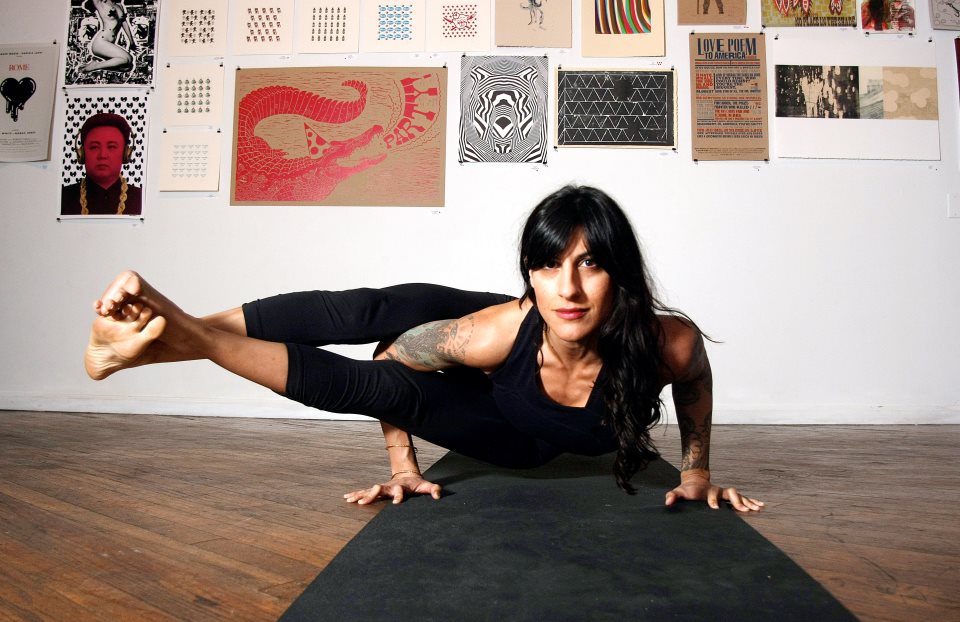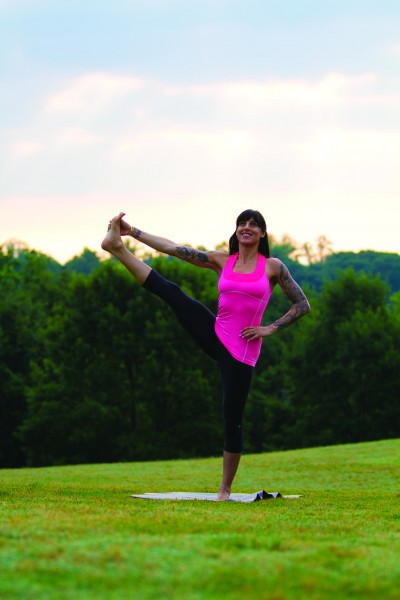Injury Prevention: Yoga for Runners
The past week here at runladylike.com has been all about injury prevention for runners. After my recent stress fracture false alarm and receiving so many messages and questions about injuries from you, I decided it was time for us to dig deeper into a topic that is so critical to every aspect of running so we can keep doing what we love.
This week, we’ve talked about basic injury prevention tips, sports massage and running in the right shoe, and we had the privilege of hearing the inspiring story of a runner who was sidelined for weeks with a partial tear to her fourth and fifth lumbar vertebrae and has recovered to run a personal best in every race distance since. As the week draws to a close, I’m excited to share the fifth and final post in my injury prevention series – a strategy I believe in wholeheartdedly: yoga.
I’ve discovered a deep stretch yoga class (aka restorative yoga) at a studio called Tough Love Yoga in Atlanta that I try to go to once a week as part of my weekly training schedule. It’s a 75-minute class designed for new studients, athletes and those recovering from injuries that focuses on working into deep postures with long holds to release tension and tightness.
Today, I’m excited to have the owner of Tough Love Yoga, Neda Draupadi Honarvar, with us to share her tips and insights for using yoga as a helpful tool to prevent running injuries.

Meet Neda …
Neda Draupadi Honarvar, E-RYT 200, is known for her fiery nature and deep desire to make yoga accessible. Neda’s teaching style reflects her passion and playfulness with her dedication to the science and discipline of yoga practice. Neda is the owner of Tough Love Yoga, the creator of Metal Yoga and a current Yoga Ambassador for lululemon athletica. She has and continues to teach all levels and ages of students in a variety of private and group settings around the Atlanta area. She has been studying yoga for more than 13 years and has completed 200-hour certifications in Classical Hatha Yoga and Kali Natha Yoga under the guidance and support of Ma Jaya Sati Bhagavati. In 2011, she also completed Anusara Immersion with Gina Minyard and Part 1 Anusara Teacher Training with Christina Sell. Neda is currently leading the first Tough Love Yoga Teacher Training, a 200-hour alignment-based hatha yoga program.
What is your favorite thing about yoga?
Everything about yoga is my favorite. I love it all. My yoga practice has taught me so much about myself, my personal growth and my relationships. My practice has revealed moments of ecstatic bliss and glimpses of unbearable pain. I’ve learned patience. I’ve learned how to forgive. I’ve learned how to tap into the most powerful aspects of myself and how to be compassionate with myself when faced with all my challenges. I’ve learned that for every bit of darkness I may see, there is as much, if not more light. Mostly, I love that, in my humble opinion, there is no mastery level … there is always room to grow and to find a deeper understanding of a pose or a concept or ourselves. The work is never done. It’s a lifelong practice and commitment.

How can yoga help prevent injuries?
I am a big science and yoga nerd so I love studying anatomy and figuring out why certain alignment and action cues we use in yoga help us prevent injury. Our bodies are very sophisticated, and we’re not always taught how to optimally move and align them. Runners and triathletes can really benefit from learning about optimal alignment and how it relates to their form. When you run or bike or swim, you’re asking your body, joints and muscle groups to perform repetitive actions over long periods of time. Learning about alignment can help you do that in safe and even therapeutic way so that you not only reduce your chance of getting injured, but may even boost your performance.
Yoga can also greatly improve your body awareness so that you’re more tuned in when your body is trying to tell you that injury might be on the way. One of my students has been long-distance running for several years and shaved 9 minutes off her half marathon time by changing nothing about her training except for adding yoga a couple times a week. That is insane. She swears by it. She says a huge part of it was learning about her breath. That is constant feedback I get from athletes. Yoga is not just about the physical postures. A huge part of it is pranayama (yogic breathing) and meditation. Pranayama teaches us how to breathe fully and in a sustainable way. It helps build lung capacity and, like meditation, helps keep you calm and centered and balanced when you’re practicing yoga, running or really doing anything. It can change your runs.
What is the best kind of yoga for runners and triathletes who are interested in injury prevention?
Finding the “best kind” of yoga is such a matter of personal preference. Some runners and triathletes will prefer and benefit more from a slower, more restorative style of yoga, while others will prefer the movement and energy of a more dynamic flow class. If injury prevention is the goal, a strong understanding of anatomy and alignment is key. Let your teacher know if you have any injuries so we can help you. It’s amazing what a little yoga therapy can do for chronic injuries.
What should we look for in a good yoga instructor/studio?
This is a tricky question and it sometimes can be a trial and error process. There are so many different teachers, studios and styles of yoga out there, and everyone has a personal preference. Look for a teacher whose teaching style resonates with you and who is interested and tuned into what is going on with your practice. You want a teacher who won’t force you beyond what your body is ready for but who will encourage you and teach you how to safely work your edge. I personally would look for a teacher who has a strong understanding of anatomy and alignment, who will offer me modifications for poses that I’m not yet ready for and who is not afraid to have fun! Look for someone willing to guide you through a safe and effective practice. We’re not always aware when our form is less than optimal or when a muscle group is over or under developed, so my personal opinion is that no matter what pace or type of class you go for, look for a teacher who will teach you about alignment and actions you can use to keep your joints, connective tissue and muscles safe, improve your form and help you find more balance in your musculature. Once I started studying alignment, I learned how to prevent injury and started being able to open muscles and get into poses I never thought I would in my lifetime. It blew my mind. And yoga doesn’t have to be so serious all the time. A fun and playful approach will keep you interested long-term.

What are your 3 favorite yoga poses for runners/athletes?
The following 3 poses are great for runners and athletes because they open the hamstrings, the outer hips and glutes and the inner thighs and groins – all areas that tend to need some extra TLC when you’re running or biking. Also, these poses take balance out of the equation so that you can concentrate on the stretch.
- Ardha Hanumanasana (aka Baby Hanuman aka Runner’s Stretch): This one is a major hamstring opener and is great for everyone. From a lunge, drop your back knee and straighten your front leg without hyperextending your knee (if you’re feeling extra tight, it’s ok to keep a slight bend in your knee). Keeping your hips square to the front of your mat, move your back knee back and front foot forward according to your comfort level. Start by sitting more upright with your hands on blocks or the floor. To move deeper into the pose, engage your core and carefully lengthen your stance or walk your hands forward and fold towards your front leg. For an extra bonus, place a foam block underneath your front leg and gently rock side to side so that the block massages out your hamstrings.
- Sucirandhrasana (aka Eye of the Needle Pose aka Supine Pigeon Pose): This pose is a variation of everyone’s favorite hip opener: Pigeon. Lay on your back with your knees bent and your feet flat on the floor. Cross your right shin over the top of your left thigh and lift your left foot off the mat to bring your legs closer to your chest. Thread your right arm through the space created by the cross of your legs and interlace your fingers behind your left knee. Flex both of your feet strongly. This will protect your knees from injury during the pose and will help open the hips more fully. To move deeper into the pose, pull your lowest belly in and start to gently draw your left knee in towards your chest and press your right knee out away from your chest. Repeat on the second side.
- Mandukasana (aka Frog Pose): Frog pose is always a favorite with my athletes. It’s a profound inner thigh and groin opener and is just fun. Start on hands and knees in a table pose. Lower down onto your forearms and begin to walk your knees out to either side away from each other. Once you have reached your first edge, look back at your shins and line them up so that they extend straight back from your knee. Flex your feet so that the inner edge of your foot is touching the mat and so that your toes are pointing out to either side. Engage your core, hug your inner thighs toward each other, and begin to shift your hips back. Be gentle and try not to force anything. Try to soften deeper into the pose with every exhale.
What if we’re not flexible?
You don’t have to be physically flexible to do yoga. You just have to be willing to be open to the possibility that with practice and patience and dedication, your muscles will gradually open and lengthen. Some of the benefits of yoga are immediate and others take time, but to me, it’s always worth the work and time you put in.
What should runners just starting yoga wear to class? Do we need yoga clothes or are running clothes ok?
I always tell people to wear whatever they find comfortable. You don’t have to wear anything fancy. You should just feel good and be able to move freely in whatever you choose. One thing to keep in mind: some poses require bending over, spreading your legs and/or getting upsidedown, so short shorts and really loose shirts are not always the best options. If you can move well in it and you’re comfortable, you’re probably on the right path!
What is your favorite yoga gear?
Two words: lululemon athletica. Not only do they make the cutest and most comfortable yoga and running clothing, but they make my favorite yoga mat of all time. It’s called “The Mat” and is the most grippy and durable mat I’ve ever used, even when you’re sweating bullets! I love those mats so much that we bought 20 of them for our rental mats at our studio. And on top of all that, lululemon does so many good things for the yoga community and supports yoga teachers and studios so fully. Those kinds of things make a difference.
How can people get in touch with you?
To learn more about Tough Love Yoga, visit our Web site (www.toughloveyoga.com) or follow us on Facebook (www.facebook.com/toughloveyoga) or Twitter (www.twitter.com/toughloveyoga). Or feel free to email me directly at Neda@toughloveyoga.com.
In case you missed the first 4 parts of this week’s injury prevention series, check them out here:
Part 1: Injury Prevention: A Week-Long Series + The Basics
Part 2: Injury Prevention: Sports Massage for Runners
Part 3: Injury Prevention: Wearing the Right Shoes
Part 4: Friday FITpiration: Overcoming Injury to Run Stronger (a personal testimonial from Holly at Fashionable Miles)
Do you make yoga part of your weekly training schedule? If so, what kind of yoga is your favorite? Has yoga helped you prevent injuries?



Comments
Great post! I’ve really been wanting to get into yoga but I don’t really have the time to get to a class. Are there any DVD’s that you would recommend?
I have not tried any DVDs but I’ve heard Paige Roundtree’s online classes are good.
Love this! Two of these poses are different from the multiple articles I’ve read about yoga for runners, and I LOVE that! Can’t wait to try these poses at home!
Thanks 😀
This is great! I have been falling in love with yoga over the last couple of years. If I’m feeling tight and sore from running, yoga always makes me feel a thousand times better! Thanks for the tips on the best poses for runners!
Great post – I’m a a big believer in yoga! It’s done a lot for my running since I started a practice.
Even while practicing yoga, I have had my fair share of running injuries. Despite that though, I still think the yoga at least helped. It’s so enriching!
I have had the pleasure of two of Neda’s classes before (at Lululemon-Howell Mill and Lenox). Two of most memorable classes ever! Neda is nothing short of awesome. Thanks for the post, Jessica!
Another awesome post! Yoga was one of the things I made sure to do religiously when in PT and after I run a race. In fact, today is yoga day! 🙂
[…] Injury Prevention: Yoga for Runners. As you know, I really have failed tried to incorporate yoga into my training. Jesica gives me even […]
Finally I have found what I was looking for. I am a Yoga instructor and have been telling my disciples who are runners that Yoga is great help for them, but I was unable to suggest them some good Yoga postures.
Can you suggest a few more Yoga postures, it would be of great help.
Thanks.
Hi Rachael! Thanks so much for stopping by! Restorative and yin yoga are so amazing to complement running! Definitely check out my friend Christine at lovelifesurf.com. She’s a yoga instructor and runner and has posted a lot of good articles on yoga for runners. I’m personally a big fan of hip openers like pigeon, double pigeon, happy baby, lizard, and dragon poses. I of course like butterfly and child’s pose too. There is also a great pose where you sit on your feet to stretch your arches that I love. You can tell I’m a runner and not a yoga expert can’t you? LOL